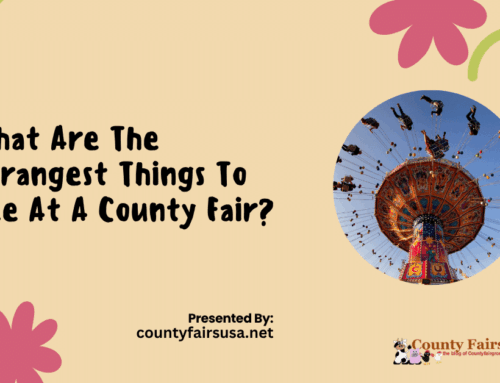County fairs have long been a cherished tradition in communities across the United States. While they are celebrated for their vibrant displays of culture, agriculture, and entertainment, their impact on local economies is often underappreciated.
How do County Fairs Contribute to Local Economies?
These events serve as significant economic engines, fostering commerce, creating jobs, and generating revenue for communities. Let’s explore the various ways in which county fairs contribute to the financial well-being of the regions they serve.
A Brief History of County Fairs
The roots of county fairs date back to the 19th century when they were primarily agricultural exhibitions. Farmers would gather to showcase their livestock, crops, and farming techniques, providing an opportunity for learning and trade. Over time, these fairs evolved into multifaceted events that include carnival rides, food vendors, concerts, and contests. Today, they attract a diverse audience, combining entertainment with economic activity.
Economic Contributions of County Fairs
Local Spending
One of the most immediate economic impacts of county fairs is the spending they generate. Visitors contribute to the local economy in several ways:
- Admission Fees: Revenue from ticket sales supports fair operations and often funds community projects.
- Food and Beverages: Vendors selling snacks, meals, and drinks see a significant boost in sales during the fair.
- Games and Rides: Carnival operators and entertainment providers benefit from high foot traffic.
- Retail Vendors: Local artisans, farmers, and small businesses have the opportunity to sell their products directly to consumers.
This influx of spending creates a ripple effect, benefiting nearby businesses such as gas stations, hotels, and restaurants.
Job Creation
County fairs are labor-intensive events that create jobs both directly and indirectly:
- Temporary Employment: Event staff, security personnel, ticket sellers, and maintenance workers are hired specifically for the fair.
- Vendor Opportunities: Local businesses employ additional workers to meet increased demand during the event.
- Performers and Entertainers: Musicians, magicians, and other entertainers often rely on fairs as a significant source of income.
These jobs provide a financial boost to individuals and contribute to the overall economy of the region.
Indirect Economic Benefits
Increased Tourism
County fairs attract visitors from surrounding areas and even from out of state. These attendees often:
- Book hotel stays for multi-day events.
- Dine at local restaurants.
- Shop at nearby retail outlets.
This influx of tourists brings fresh revenue to local businesses and enhances the area’s reputation as a travel destination.
Infrastructure Development
Hosting a county fair often necessitates improvements to local infrastructure, including:
- Upgraded fairgrounds.
- Enhanced transportation systems.
- Improved utilities such as electricity and water supplies.
These upgrades benefit the community long after the fair has concluded, creating a more attractive environment for residents and businesses alike.
Support for Local Agriculture
County fairs remain a vital platform for farmers to showcase their products and connect with consumers. Through livestock auctions, produce competitions, and educational displays, they:
- Promote agricultural products and practices.
- Encourage direct sales of fresh produce and homemade goods.
- Foster a connection between rural producers and urban consumers.
Community and Cultural Impact
County fairs are more than economic events; they are cultural gatherings that foster community spirit. This cultural enrichment contributes to the local economy in subtle but meaningful ways:
- Repeat Visitors: A positive experience at the fair encourages attendees to return year after year.
- Brand Recognition: The fair becomes a hallmark of the region, drawing larger crowds over time.
- Volunteerism: Many fairs rely on local volunteers, reducing operational costs while engaging the community.
Challenges and Opportunities
While county fairs provide substantial economic benefits, they also face challenges that can limit their impact. Rising costs of operation, competition from other entertainment options, and unpredictable weather can all affect attendance and revenue.
Opportunities for Growth:
- Partnerships with Local Businesses: Collaborating with local entrepreneurs can expand the range of products and services available at the fair.
- Digital Marketing: Promoting the event through social media and online platforms can attract a wider audience.
- Sustainability Practices: Incorporating eco-friendly initiatives can appeal to environmentally conscious attendees and reduce operational costs.
Real-Life Examples
Across the United States, county fairs have demonstrated their ability to stimulate economic growth. For instance:
- The Minnesota State Fair generates millions of dollars annually, supporting hundreds of jobs and attracting tourists from across the country.
- The Iowa State Fair is a platform for agricultural promotion, helping local farmers reach new customers and markets.
- Smaller County Fairs often become the economic highlight of the year for rural communities, bringing in revenue that supports local schools, charities, and public services.
Looking Ahead
As county fairs continue to evolve, their role in supporting local economies remains vital. Embracing innovation and responding to community needs will ensure their relevance for generations to come. From fostering commerce to strengthening cultural ties, these events are invaluable to the regions they serve.
Conclusion
County fairs are more than just fun-filled community events; they are a cornerstone of local economic activity. Through increased spending, job creation, and support for agriculture, they provide tangible financial benefits while enriching the cultural fabric of their communities. By understanding and appreciating their economic significance, we can ensure that county fairs continue to thrive and contribute to the prosperity of local economies.







Leave A Comment